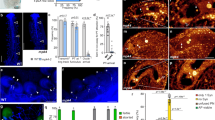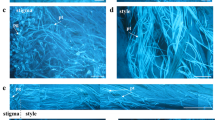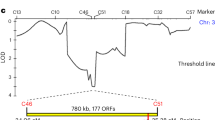Abstract
Pollen–pistil interactions are crucial for controlling plant mating. For example, S-RNase-based self-incompatibility prevents inbreeding in diverse angiosperm species. S-RNases are thought to function as specific cytotoxins that inhibit pollen that has an S-haplotype that matches one of those in the pistil. Thus, pollen and pistil factors interact to prevent mating between closely related individuals. Other pistil factors, such as HT-B, 4936-factor and the 120 kDa glycoprotein, are also required for pollen rejection but do not contribute to S-haplotype-specificity per se. Here we show that S-RNase is taken up and sorted to a vacuolar compartment in the pollen tubes. Antibodies to the 120 kDa glycoprotein label the compartment membrane. When the pistil does not express HT-B or 4936-factor, S-RNase remains sequestered, unable to cause rejection. Similarly, in wild-type pistils, compatible pollen tubes degrade HT-B and sequester S-RNase. We suggest that S-RNase trafficking and the stability of HT-B are central to S-specific pollen rejection.
This is a preview of subscription content, access via your institution
Access options
Subscribe to this journal
Receive 51 print issues and online access
$199.00 per year
only $3.90 per issue
Buy this article
- Purchase on Springer Link
- Instant access to full article PDF
Prices may be subject to local taxes which are calculated during checkout





Similar content being viewed by others
References
de Nettancourt, D. Incompatibility and Incongruity in Wild and Cultivated Plants (Springer, Berlin, 2001)
Kao, T.-h. & Tsukamoto, T. The molecular and genetic bases of S-RNase-based self-incompatibility. Plant Cell 16, S72–S83 (2004)
Murfett, J., Atherton, T. L., Mou, B., Gasser, C. S. & McClure, B. A. S-RNase expressed in transgenic Nicotiana causes S-allele-specific pollen rejection. Nature 367, 563–566 (1994)
Lee, H.-S., Huang, S. & Kao, T.-h. S proteins control rejection of incompatible pollen in Petunia inflata. Nature 367, 560–563 (1994)
Cornish, E. C., Pettitt, J. M., Bonig, I. & Clarke, A. E. Developmentally controlled expression of a gene associated with self-incompatibility in Nicotiana alata. Nature 326, 99–102 (1987)
Anderson, M. A. et al. Sequence variability of three alleles of the self-incompatibility gene of Nicotiana alata. Plant Cell 1, 483–491 (1989)
McClure, B. S-RNase and SLF determine S-haplotype-specific pollen recognition and rejection. Plant Cell 16, 2840–2847 (2004)
Entani, T. et al. Comparative analysis of the self-incompatibility (S-) locus region of Prunus mume: Identification of a pollen-expressed F-box gene with allelic diversity. Genes Cells 8, 203–213 (2003)
Sijacic, P. et al. Identification of the pollen determinant of S-RNase-mediated self-incompatibility. Nature 429, 302–305 (2004)
Ikeda, K. et al. Primary structural features of the S haplotype-specific F-box protein, SFB, in Prunus. Sex. Plant Reprod. 16, 235–243 (2004)
Ushijima, K. et al. The S haplotype-specific F-box protein gene, SFB, is defective in self-compatible haplotypes of Prunus avium and P. mume. Plant J. 39, 573–586 (2004)
Ushijima, K. et al. Structural and transcriptional analysis of the self-incompatibility locus of almond: Identification of a pollen-expressed F-box gene with haplotype-specific polymorphism. Plant Cell 15, 771–781 (2003)
McClure, B. A., Cruz-Garcia, F., Beecher, B. S. & Sulaman, W. Factors affecting inter- and intra-specific pollen rejection in Nicotiana. Ann. Bot. 85, 113–123 (2000)
McClure, B. A., Mou, B., Canevascini, S. & Bernatzky, R. A small asparagine-rich protein required for S-allele-specific pollen rejection in Nicotiana. Proc. Natl Acad. Sci. USA 96, 13548–13553 (1999)
O'Brien, M. et al. Molecular analysis of the stylar-expressed Solanum chacoense asparagine-rich protein family related to the HT modifier of gametophytic self-incompatibility in Nicotiana. Plant J. 32, 1–12 (2002)
Kondo, K. et al. Cultivated tomato has defects in both S-RNase and HT genes required for stylar function of self-incompatibility. Plant J. 29, 627–636 (2002)
Kondo, K. et al. Insights into the evolution of self-compatibility in Lycopersicon from a study of stylar factors. Plant J. 30, 143–153 (2002)
Lind, J. L., Bacic, A., Clarke, A. E. & Anderson, M. A. A style-specific hydroxyproline-rich glycoprotein with properties of both extensins and arabinogalactan proteins. Plant J. 6, 491–502 (1994)
Lind, J. L., Bönig, I., Clarke, A. E. & Anderson, M. A. A style-specific 120 kDa glycoprotein enters pollen tubes of Nicotiana alata in vivo. Sex. Plant Reprod. 9, 75–86 (1996)
Cruz-Garcia, F., Hancock, C. N., Kim, D. & McClure, B. Stylar glycoproteins bind to S-RNase in vitro. Plant J. 42, 295–304 (2005)
Hancock, C. N., Kent, L. & McClure, B. The 120 kDa glycoprotein is required for S-specific pollen rejection in Nicotiana. Plant J. 43, 716–723 (2005)
Martin, F. W. The behaviour of Lycopersicon incompatibility alleles in an alien genetic milieu. Genetics 60, 101–109 (1968)
Ai, Y., Kron, E. & Kao, T.-h. S-alleles are retained and expressed in a self-compatible cultivar of Petunia hybrida. Mol. Gen. Genet. 230, 353–358 (1991)
Tsukamoto, T. et al. Breakdown of self-incompatibility in a natural population of Petunia axillaris (Solanaceae) in Uruguay containing both self-incompatible and self-compatible plants. Sex. Plant Reprod. 12, 6–13 (1999)
Tsukamoto, T. et al. Breakdown of self-incompatibility in a natural population of Petunia axillaris caused by a modifier locus that suppresses the expression of an S-RNase gene. Sex. Plant Reprod. 15, 255–263 (2003)
Bernatzky, R., Glaven, R. H. & Rivers, B. A. S-related protein can be recombined with self-compatibility in interspecific derivatives of Lycopersicon. Biochem. Genet. 33, 215–225 (1995)
Luu, D.-T., Xike, Q., Morse, D. & Cappadocia, M. S-RNase uptake by compatible pollen tubes in gametophytic self-incompatibility. Nature 407, 649–651 (2000)
McClure, B. A., Gray, J. E., Anderson, M. A. & Clarke, A. E. Self-incompatibility in Nicotiana alata involves degradation of pollen rRNA. Nature 347, 757–760 (1990)
Qiao, H. et al. The F-box protein AhSLF-S2 physically interacts with S-RNases that may be inhibited by the ubiquitin/26S proteasome pathway of protein degradation during compatible pollination in Antirrhinum. Plant Cell 16, 582–595 (2004)
Sonneveld, T., Tobutt, K. R., Vaughan, S. P. & Robbins, T. P. Loss of pollen-S function in two self-compatible selections of Prunus avium is associated with deletion/mutation of an S haplotype-specific F-box gene. Plant Cell 17, 37–51 (2005)
Qiao, H. et al. The F-box protein AhSLF-S2 controls the pollen function of S-RNase-based self-incompatibility. Plant Cell 16, 2307–2322 (2004)
Hicks, G. R., Rojo, E., Hong, S., Carter, D. C. & Raikhel, N. V. Germinating pollen has tubular vacuoles, displays highly dynamic vacuole biogenesis, and requires VACUOLESS1 for proper function. Plant Physiol. 134, 1227–1230 (2004)
Rogers, S. W., Burks, M. & Rogers, J. C. Monoclonal antibodies to barley aleurain and homologs from other plants. Plant J. 11, 1359–1368 (1997)
Jauh, G.-Y., Phillips, T. E. & Rogers, J. C. Tonoplast intrinsic protein isoforms as markers for vacuolar functions. Plant Cell 11, 1867–1882 (1999)
van Deurs, B. et al. Estimation of the amount of internalized ricin that reaches the trans-golgi network. J. Cell Biol. 106, 253–267 (1988)
Wesche, J., Rapak, A. & Olsnes, S. Dependence of ricin toxicity on translocation of the toxin A-chain from the endoplasmic reticulum to the cytosol. Proc. Natl Acad. Sci. USA 274, 34443–34449 (1999)
Geitmann, A. in Fertilization in Higher Plants (eds Cresti, M., Cai, G. & Moscatelli, A.) (Springer, Berlin/Heidelberg, 1999)
Macintosh, G. C., Bariola, P. A., Newbigin, E. & Green, P. J. Characterization of Rny1, the Saccharomyces cerevisiae member of the T2 RNase family of RNases: Unexpected functions for ancient enzymes? Proc. Natl Acad. Sci. USA 98, 1018–1023 (2001)
Murfett, J. M. et al. S RNase and interspecific pollen rejection in the genus Nicotiana: Multiple pollen rejection pathways contribute to unilateral incompatibility between self-incompatible and self-compatible species. Plant Cell 8, 943–958 (1996)
Beecher, B. & McClure, B. A. Effects of RNases on rejection of pollen from Nicotiana tabacum and N. plumbaginifolia. Sex. Plant Reprod. 14, 69–76 (2001)
Kho, Y. O. & Baer, J. Observing pollen tubes by means of fluorescence. Euphytica 17, 299–302 (1968)
Paris, N. & Rogers, J. C. The role of receptors in targeting soluble proteins from the secretory pathway to the vacuole. Plant Physiol. Biochem. 34, 223–237 (1996)
Tanner, V. A., Ploug, T. & Tao-Cheng, J. H. Subcellular localization of SV2 and other secretory vesicle components in PC12 cells by an efficient method of preembedding EM immunocytochemistry for cell cultures. J. Histochem. Cytochem. 44, 1481–1488 (1996)
Acknowledgements
We thank M. Kroll for manuscript assistance; H. Sassa for helpful discussions; J. Rogers for antibodies; and C. S. Gasser, S. J. Hiscock and C. Staiger for pre-review. The MU-Monsanto Plant Biology Program and grants from the US National Science Foundation supported this work. F.C.-G. was also supported by a grant from the Universidad Nacional Autonoma de Mexico.
Author information
Authors and Affiliations
Corresponding author
Ethics declarations
Competing interests
Reprints and permissions information is available at npg.nature.com/reprintsandpermissions. The authors declare no competing financial interests.
Supplementary information
Supplementary Notes
This PDF file contains Supplementary Figs 1-4, 7 and 8 along with the legends for these figures. The file also contains a Supplementary Methods section and the legends for Supplementary Video Figs. 5 and 6. (PDF 413 kb)
Supplementary Movie S5
Compartmentalization in a compatible pollination. Animation of the image stack in Figure 2a (compatible, 16 h). The animation pans up and down through the image stack from two different views. (MOV 5637 kb)
Supplementary Movie S6
Compartment breakdown in an incompatible pollination. Animation of the image stack in Figure 2e (incompatible, 36 h). The animation pans up and down through the image stack from two different views. (MOV 7126 kb)
Rights and permissions
About this article
Cite this article
Goldraij, A., Kondo, K., Lee, C. et al. Compartmentalization of S-RNase and HT-B degradation in self-incompatible Nicotiana. Nature 439, 805–810 (2006). https://doi.org/10.1038/nature04491
Received:
Accepted:
Issue Date:
DOI: https://doi.org/10.1038/nature04491
This article is cited by
-
Genetics Behind Sexual Incompatibility in Plants: How Much We Know and What More to Uncover?
Journal of Plant Growth Regulation (2023)
-
Corals regulate the distribution and abundance of Symbiodiniaceae and biomolecules in response to changing water depth and sea surface temperature
Scientific Reports (2021)
-
LC–MS based metabolic fingerprinting of apricot pistils after self-compatible and self-incompatible pollinations
Plant Molecular Biology (2021)
-
Assessing the Contribution of Sli to Self-Compatibility in North American Diploid Potato Germplasm Using KASP™ Markers
American Journal of Potato Research (2021)
-
Developing self-compatible diploid potato germplasm through recurrent selection
Euphytica (2021)
Comments
By submitting a comment you agree to abide by our Terms and Community Guidelines. If you find something abusive or that does not comply with our terms or guidelines please flag it as inappropriate.



